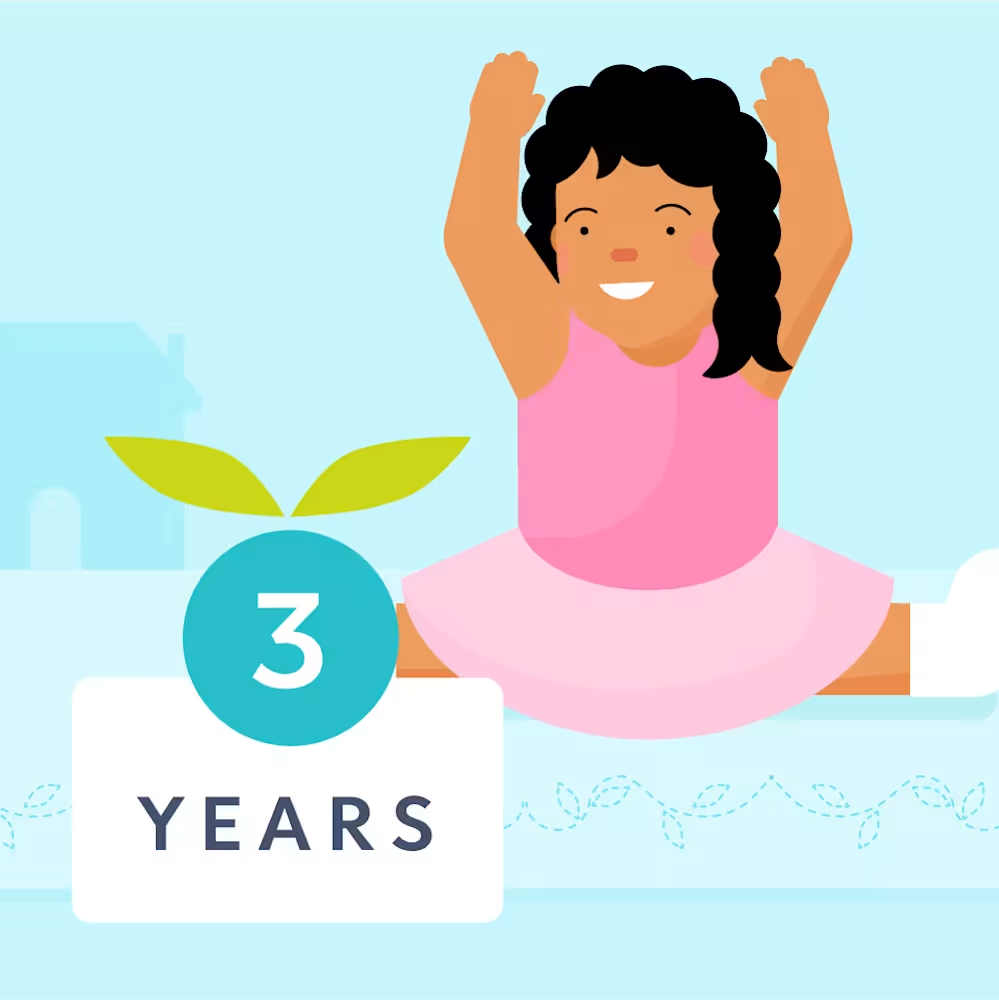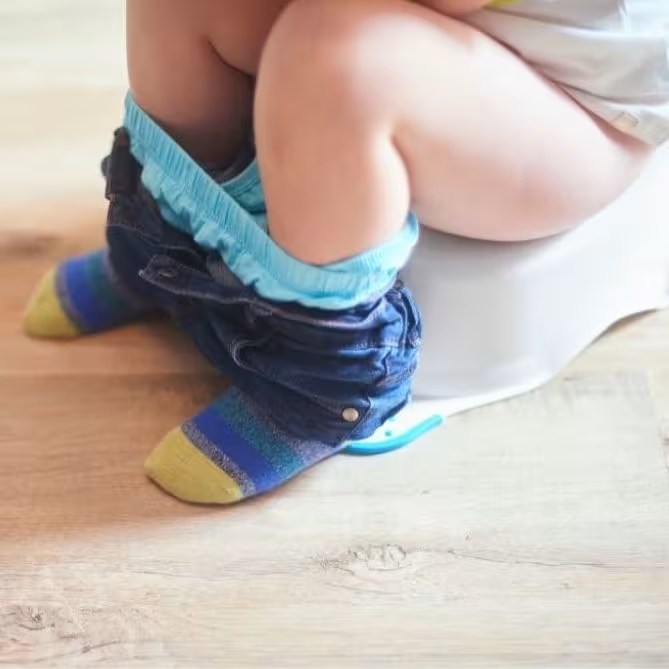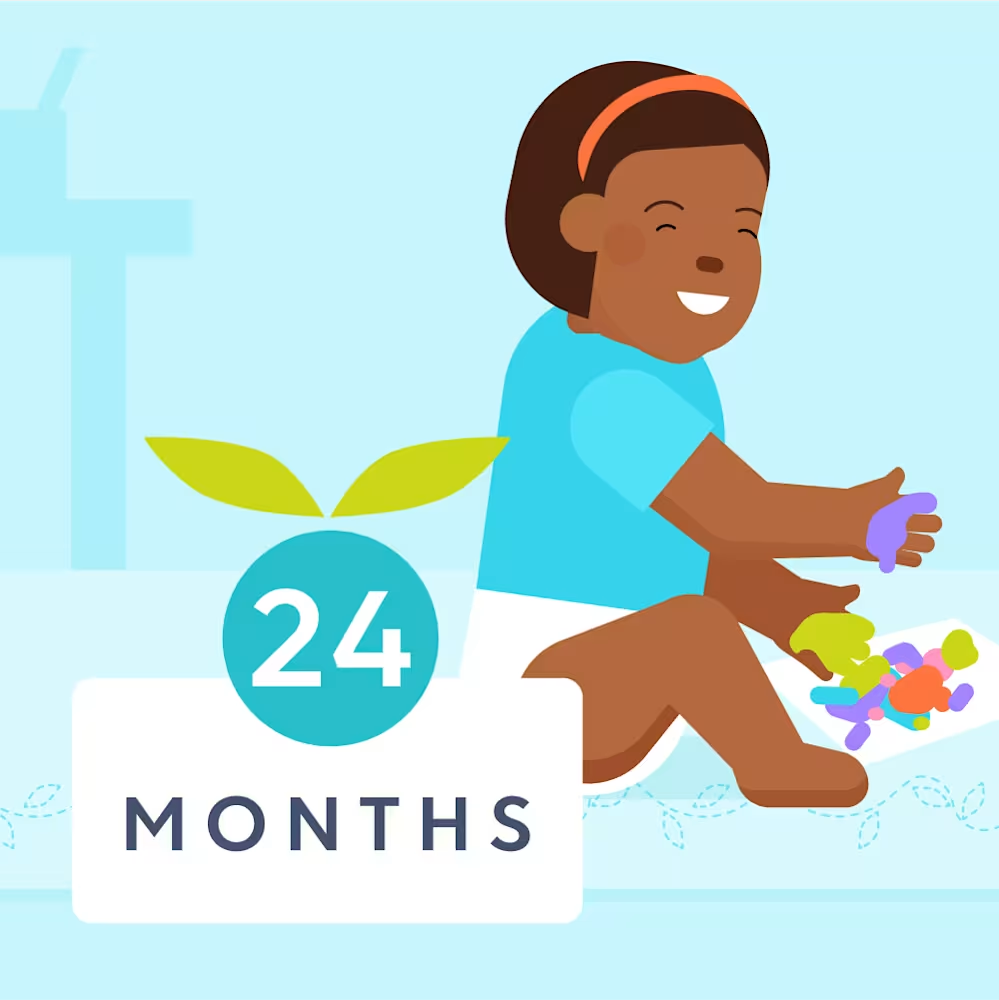30 month old / 2.5 year old sleep schedule: Bedtime and nap schedule
Updated Dec 15, 2025

There are times when getting your toddler to sleep may feel like you need the combined skills of a seasoned mediator and a renowned magician. After all, your 2.5 year old may be exploring how to test limits while also, experiencing separation anxiety, and developing new nighttime fears all at once! We have good news — nope, it’s not a magic wand. Instead, these developmentally appropriate challenges are often eased by time and following a suitable schedule.
Editor's note
The recommendations listed below represent the average amount of sleep typically needed at this age. However, please note there is a range of normal as some children have lower or higher sleep needs. Your child’s schedule may vary, and that is normal.
Table of Contents
How much should a 2.5 year old sleep?
We typically recommend aiming for about 12 hours of sleep (or more) in a 24-hour period at this age. The American Academy of Pediatrics (AAP) recommends that children 1 and 2 years of age get 11 - 14 hours of total sleep for optimal health []. Since recommendations and individual sleep needs vary, we suggest factoring in your child’s mood and energy levels when assessing if they’re getting the shuteye they need.
Here's a quick overview of what you may expect when it comes to 30 month olds and sleep. Note that these figures are averages and should be used as guidelines.
| Average total sleep | 12 hours |
| Number of naps | 1 |
| Goal daytime sleep | 1 - 2 hours |
| Wake windows | 6 hours |
How many naps for a 30 month old?
Most 2.5 year olds still need that lasts around 1 - 2 hours. As kiddos get closer to 3, they’ll be able to comfortably stay awake for longer periods, meaning you may see a resurgence of nap resistance. Who wants to nap when you can stay up and play?! Aiming for 6 hours of wake time before the nap can make it easier for your child to fall asleep.
Sample 2.5 year old sleep schedule

Note: Sleep needs vary by child and this chart should be viewed as an example.
Morning rise: 7:00 AM
Wake window before nap: 6 hours
Nap: 1:00 PM - 2:30 PM (1.5 hour nap)
Get ready for bed: 7:45 PM
Wake window before bedtime: 6 hours
Asleep: 8:30 PM
2.5 year old nap schedule
Let's continue to break down a 30 month old nap schedule. At this age, most children still need one daily nap. However, there are times when toddlers may take very short naps or skip. Here's how we'd recommend navigating a regular schedule and also a skipped-nap day.
| Morning rise | 7:00 AM |
| Nap | 1:00 PM - 2:30 PM (1.5 hour nap); 6 hours awake time before nap |
| Get ready for bed | 7:45 PM |
| Asleep | 8:30 PM; 6 hours awake time before bedtime |
Note: Sleep needs vary by child and this chart should be viewed as an example.
Skipped-nap schedule
If your child does skip a nap, offer an earlier bedtime to help limit overtiredness and lengthen nighttime sleep. Here’s an example of a sleep schedule for a 2.5 year old without a nap:
| Morning rise | 7:00 AM |
| Skipped nap | Child didn’t sleep |
| Get ready for bed | 6:45 PM |
| Asleep | 7:30 PM earlier bedtime |
Note: Sleep needs vary by child and this chart should be viewed as an example.
Bedtime for a 2.5 year old
It’s common for bedtime to be between 7:00 - 9:00 PM at this age. Bedtime should allow for 10 - 12 hours of sleep and may vary depending on whether your kiddo napped that day. When determining the best sleep schedule for your 30 month old, you'll want to look at their typical daytime sleep patterns. Toddlers who nap for 2 hours a day may only be able to sleep for 10 hours at night, whereas a 2.5 year old who skips their nap may be able to sleep for 12 hours at night.
While a consistent bedtime is beneficial for a child’s overall sleep schedule, being flexible with timing when your child skips or has a short nap is often preferable. If kiddos skip a nap and go to bed at their normal bedtime, they are likely to be overtired and that can create a cycle of sleeping in later and then resisting a nap the next day. If bedtime is moved earlier, your child will ideally wake up at their regular morning rise time and nap the next day.
Can you sleep train a 2.5 year old?
can be an effective tool for children at this age. While this usually helps improve night sleep, sleep training during the day at this age isn’t always as successful. Some children may drop their nap prematurely rather than learn a new way of falling asleep at naptime. Keep in mind many children go through phases of resisting daytime sleep at this age, though most won’t be ready to fully go without napping until closer to 3.
Is there a sleep regression at 30 months?
A variety of factors and milestones can impact sleep at this age, and it’s common to see skipped naps, bedtime resistance, and early waking as a result. If this is the case, we’d refer to this patch of bumpy sleep as a “.” However, there’s no magical date on the calendar that determines when sleep patterns decline.
Why does my 2.5 year old keep waking up at night crying?
If you’ve frantically googled why 2 year olds suddenly go through periods of bumpy sleep, you’re not alone. At this age, toddlers continue to test boundaries, master new milestones, and may go through life changes like welcoming a sibling or starting a new daycare. They may get more pesky molars too! Any of these things (or a combination of them!) can contribute to new night waking. If you’re looking for more sleep support, consider submitting for a personalized, step-by-step Sleep Plan via .
Can my 30 month old sleep with a pacifier?
It’s common for caregivers to contemplate getting rid of beloved pacifiers at this age. The American Academy of Pediatric Dentistry cautions against pacifiers into toddlerhood and beyond because prolonged use may influence the developing structures and functions of a child’s face and mouth, like an anterior open bite (when upper and lower front teeth don’t overlap or touch when the mouth is closed) and other dental issues []. In these cases, orthodontic treatment may be needed.
Can a 30 month old sleep on their stomach or side?
If your child falls asleep on their side or stomach and can easily move on their own, it’s OK to go ahead and leave them in these positions.
What are the developmental milestones for a 30 month old?
At 30 months, your kiddo may have mastered some milestones in some areas and may be working towards milestones in others. There’s a wide range of normal at this stage of development and that’s normal.
Here are some things your child may be trying at 2.5:
Turns a single page of a book
Holds and crayon and scribbles spontaneously
Stacks 4 blocks by 24 months and 10 blocks by 36 months
Says 200 - 1,000 words by 3 years old
Uses short sentences and phrases
Starting to name body parts and animals
Expresses a range of emotions
Notices when other people are upset or hurt
Says “no!” frequently and has temper tantrums
Engages in parallel play with other children
Does a 30 month old need to eat during the night?
Eating during the night is typically . If your toddler is waking up hungry during the night (or very early in the morning), consider offering a healthy pre-bedtime snack to help them stay full until breakfast. Try cheese and crackers or peanut butter on toast, for example.
Takeaway
Most 30 month olds need about 12 hours of sleep over 24 hours to be sufficiently rested. This typically includes overnight sleep and a daily nap that lasts 1 - 2 hours.
Nap resistance is common at this age. It’s normal (and frustrating!) if your kiddo goes through periods of skipping daytime sleep. However, most children aren’t quite ready to ditch naps altogether until closer to 3.
If your child has a short or skipped nap, consider moving bedtime earlier that night to limit overtiredness.
If you're curious about what lies ahead, glimpse into the future to see what you might experience once your baby is on a . Also check out a to see how far your little one has come.
30 month old FAQ
Share article:
Note: The content on this site is for informational purposes only and should not replace medical advice from your doctor, pediatrician, or medical professional. If you have questions or concerns, you should contact a medical professional.
2 Sources
Table of Contents
Share article:








